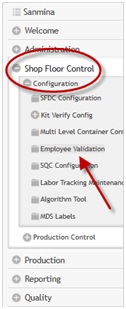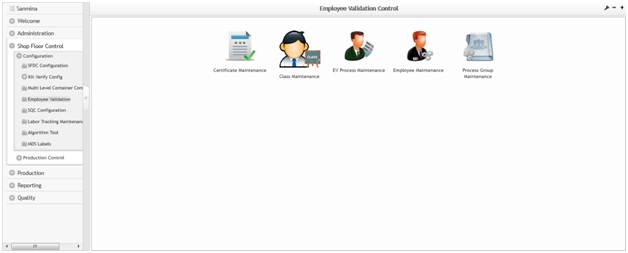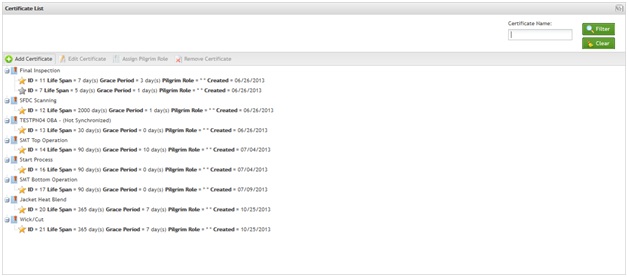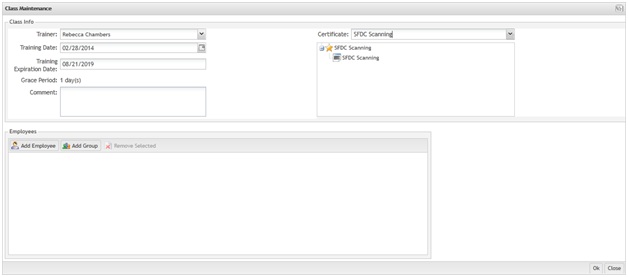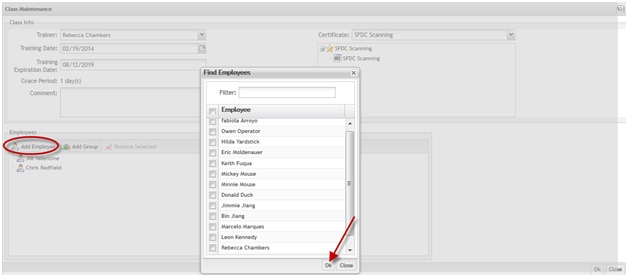SOP-MES0019 Employee Validation
This edition applies to MES15 Portal 1.0 Application and all subsequent releases and modifications until otherwise indicated in new revisions.'
Contents
Employee Validation Setup
This edition applies to MES15 Portal 1.0 (Employee Validation Module) and all subsequent releases and modifications until otherwise indicated in new revisions.
This module is responsible for creating trainings that operators should perform to work in manufacturing processes. The whole operator control (registration and information maintenance) and trainings and certificates required for the operators work in shop floor (mainly in medical plants) will be administered by this feature.
Employee Validation is a manual input module that allows individuals working on the employee other than those creating a new configuration and maintaining an existing one.
It provides a method of creating employee / password / training records that can be administered by non-SFDC personnel, and provides a method of identifying specific processes that must be controlled.
It will still support the traditional login methods for data collectors without controlled processes.
Employee Validation is accessed using two paths:
1. Shop Floor Control > Configuration > Employee Validation
2. Quality > Employee Validation.
The Certificate, EV Process, and Process Group maintenance sub-modules are available only through path 1, which is known as EV Configuration. Class Maintenance and Employee Maintenance sub-modules are available only through path 2, which is known as EV Maintenance.
These instructions address the path 1 (EV Configuration) sub-modules.
Figure 1: MES Modules
The Employee Validation Maintenance page is displayed as follows:
Figure 2: Employee Validation Maintenance
Employee Validation is composed by sub-modules and these work instructions will help users to understand each one.
- Employee Maintenance
- EV Process Maintenance
- Process Group Maintenance
- Certificate Maintenance
- Class Maintenance
Process Maintenance
Processes are created in the SFDC Maintenance module. In EV, the user is able to add these processes. The added processes are those that EV will download to SFDC and check for Classes. In this step the user is able to add, edit, remove, and re-add processes and process groups that will be managed inside the Employee Validation Module.
| To access the EV Processes Maintenance, navigate to Shop Floor Control > Configuration > Employee Validation and select EV Process Maintenance from the main page. The Process list main page is displayed. |
Listing Process
Figure 12: Processes List
1. To search, type the process name into the Filter field. Search results are generated as the user enters letters into the field.
Adding Processes
Figure 13: Add Process List
The available processes are displayed to be added in EV.
1. To define the processes to be controlled by EV, double-click a process on the left-hand side of the page. The selected processes are moved to the process list on the right-hand side of the page and are highlighted in yellow.
2. If preferred, move all processes over by selecting Save All Processes.
3. Select Save to update or Reset to cancel.
NOTE: If there are multiple processes that are to be controlled by Employee Validation, yet fall into the same certification, these processes can be grouped together by defining a process group. Click on the Process Group Maintenance module. See the Process Group Maintenance section for specific instructions on how to create process groups.
Editing Processes
To Edit (Enable and Disable) Processes, follow the steps below.
Figure 14: Edit Processes
1. Select the processes to be updated and click the Enable/Disable icon.
2. Click on Yes to complete the action or No to cancel.
NOTE: The process will be disabled when it is not used, but it can be used anytime by enabling it.
Removing Processes
To remove a process, select the process and select the Remove button.
Figure 15: Remove Processes
NOTE: Users cannot remove any processes that have assigned certificates.
Undo a Delete
1. To undo a deletion of a process, select the Undo Delete icon. The selected process will change the color and continue displaying in the list.
Figure 16: Undo Delete Processes
2. Select Yes to complete the action, or No to cancel.
Process Group Maintenance
To access the Process Group Maintenance, navigate to Shop Floor > Configuration > Employee Validation, and click on Process Group Maintenance from the main menu.
Adding Process Groups
To add process groups, follow the steps below:
Figure 17: Add Process Groups
1. To add process groups, select the Add icon, enter the Process Group Name, and select the processes to be added into the process group. The selected Process Group will be displayed in yellow. Selecting the process group, the user can see all assigned processes.
NOTE: Every time that a new process group is created, the user must associate at least one process to it.
Selecting a process group, the user can see all assigned processes.
2. Select Save to add the process group, or Close to cancel.
Editing Process Group Name
Figure 18: Edit Process Groups
1. To edit a process group name, select the process group and select the Edit icon.
Only the process group name can be updated. Update the name and select Save to complete the action. To cancel, select Close.
Editing Process Group Status
Figure 19: Change Process Group
1. To change the process group status, in the Process Groups list check the box of a group and select the Edit icon.
NOTE: The updated Process Group is displayed in red:
2. Select Yes to complete the edit, or No to cancel.
Removing Process Group
Figure 20: Remove Process Group
1. To Remove Process Group from list, select the process group and select Remove.
NOTE: Users cannot remove process groups with assigned certificates.
Undo Delete Process Group
Figure 21: Undo Delete Process
1. To undo delete a process group, select the Undo Delete icon. The selected process group color will be changed and continue displaying in the list.
2. Select Yes to delete, or No to cancel.
Process Maintenance
Searching Process
Figure 22: Filter Processes
1. To filter processes already assigned to a Process Group, enter the process name in the Filter field. The process displays with the respective assigned process group.
Adding Process
Figure 23: Add Process
1. To Add Process, check the box of the group from the Process Groups list and select the Add Process icon on the right-hand side. The available processes are displayed.
2. Select the process and click Save. The selected processes will be displayed in the Processes list. This action could be affecting existing Certificates and the user is able to update it.
NOTE: A process can only belong to a single Process Group.
Removing Process
Figure 24: Remove Process
1. To remove a process, check the box of the process group, then check the box of the process to be removed, and click the Remove Process icon.
If the update on the process group affects existing certificates, the user is alerted and has the option to change the certificate before saving the change.
2. Click Save to finish the removal, or click Close to cancel.
Certificate Maintenance
To access the Certificates Maintenance, navigate to Quality > Employee Validation and select Certificate Maintenance from the Employee Validation main page. The main certificate maintenance page displays.
Certificate List
Figure 25: Certificate List
Adding Certificates
1. To add certificates and associate processes and process groups or parts/families to certificates, click on Add Certificate in the Certificate List page. The Certificate Maintenance screen displays.
Figure 26: Add Certificate
1. Complete the fields with the appropriate information:
- Certificate Name: The name of the new certificate.
- Pilgrim Role: Used to assign a certificate to a Pilgrim role. It was created to maintain a list of the roles in Pilgrim that require training for EV purposes and are linked to the EV certificates assigned to the respective roles.
- Life Span: The number of days a certificate is valid.
- Grace Period: The number of days allowed after expiration (cannot be greater than 30).
2. Click on Ok to confirm. The new certificate must display in the Certificate list.
3. Click on the Add Process / Process Group tab to define the process or group that is assigned to the certificate (see the expanded instructions below).
Adding Process/Process Group to the certificate:
Figure 27: Certificate X Process/Process Group
Use the Process/Process Group tab to define the process or group that is assigned to the certificate.
1. Select the Process Groups check box to add process groups available in the list. Do the same steps to Processes and click on the Add button. The inserted process/process group is displayed in the Process/Process Group tab.
NOTE: You cannot create a certificate without having at least one process or group assigned.
Figure 28: Certificate Maintenance Process/Process Group Tab
2. To add a process to the process groups, select Add Process. The added processes/process groups are shown highlighted.
Creating generic certificates:
If multi-pass device numbers are used in SFDC, then it is recommended to create a generic certificate and assign some process to it. The process does not have to exist in any route. An example would be SFDC Training for the process. The process is not used for any locations or in any route. The process is controlled by Employee Validation and a generic certificate is created for this process.
All employee numbers are assigned to this certificate/process. The reason for this is to allow any employee to log into a device number that has one or more EV controlled processes. Without a generic certificate/process, employees would not be able to log into the device number to perform the non-EV controlled processes that are assigned to the multi-pass device number. Employee validation ensures that serial numbers that are at a controlled process and can only be scanned by employees that have the necessary certification for the controlled process. Without the generic certificate/process, non-certified employees will not be able to log into multi-pass device numbers.
Remove a 'Certificate 'Process/Process Group:
Figure 29: Remove Process Group
1. Click the process/process group to select it and click on Remove Selected button. The removed process/process group displays in dark gray in the list.
2. To undo, select it from list and click on Undo.
Adding Part Number/Part Family/Customer Code to Certificates:
Figure 30: Part Number/Part Family/Customer Code Tab
Users can also add Part Numbers/Family and Customer Codes to the Certificate by using the portlets under the Part Number/Part Family/Customer Code tab. The steps to add, remove, and undo remove are the same as described above for Process and Process Group.
Figure 31: Customer Code
1. To add customer code, select the items in the list and click on Ok.
Figure 32: Part Family
1. To add part numbers/family, select the items in the list and click Ok when finished, or Close to cancel.
Editing Certificates
1. To edit certificates, select the certificate in the Certificate List and follow the same instructions to Add Certificates: update the mandatory fields and click on Ok to commit the change.
Figure 33: Certificate Maintenance
NOTE: Every time the user adds a new process to a certificate, the application creates a new instance of that certificate. All classes created before the certificate changes will be linked to the old certificate instance.
Consider the following scenario:
1- Create Certificate CERT with process A and B.
2- Create a Class for CERT with employees Thomas and Keith.
3- Edit CERT and add the new process C.
On this example the employees Thomas and Keith will be trained only on the processes A and B. If the certificate is changed, they will need to be trained on process C as well; therefore, another class will need to be created for the same CERT.
Figure 34: Certificate Instances
In the Certificate List, processes that are listed as a gold star represents the last update, while silver stars are the old processes that are assigned to the classes already created.
Removing Certificates
To remove certificates from the list, follow the steps below:
1. Select the certificate to be removed.
2. Select Remove Certificate. A pop-up message displays to confirm the certificate removal.
3. Select Yes to confirm, select No to cancel.
Figure 35: Remove Certificate from List
NOTE: Certificates already assigned with classes cannot be removed.
Class Maintenance
To access the Class Maintenance, navigate to Quality > Employee Validation and select Class Maintenance from the Employee Validation main page. The Class Maintenance main page is displayed.
Figure 36: Class Maintenance
The user is able to add, copy, or edit classes and perform searches from the main class page.
Adding Classes
Figure 37: Add Class
1. Click on Add Class in the Menu bar. The Class Maintenance page displays.
Figure 38: Class Maintenance
2. Select the trainer, the certificate and the date for training from the drop-down list. When the certificate is selected, the Grace Period and Training Expiration Date will automatically be filled.
3. Next, select Add Employee from the Class Maintenance page. The Find Employees pop-up appears.
NOTE: The class must have at least one assigned certificate.
Figure 39: Add Employees
4. Select employees from the list and click Ok to add the employees, or Close to cancel the action.
Adding Employee Groups
1. To add employee groups, Click on Add Group from the Class Maintenance page. The Find Groups pop-up displays to find groups.
2. Select a group and click on Ok to add the employee group, or Close to cancel. Both groups and employees will be displayed in the employees list.
Figure 40: Add Employees Groups
NOTE: The add employees by group is a way to make adding employees fast and EV does not store group information (i.e., if the selected group has a new employee added in the future, he or she will not be added to the class).
Editing Classes
To Edit Classes, select the class to be edited and click on Edit icon. Follow the same steps performed to add classes. Click Ok to complete the changes, or Close to cancel.
Figure 41: Editing Classes
NOTE: Classes cannot be deleted.
SFDC setup to enable Employee Validation
After completing the configuration of Employee Validation, the configuration must be downloaded to the SFDC PC in order to take effect.
To download the Employee Validation configuration, perform an emvdnld on the SFDC PC. Refer to the SFDC Operations manual for additional information. Two OPTIONS lines (OPTIONS EMPVAL VALIDATION=YES and OPTIONS EMPVAL_PROD PRODUCT=pbm) must be enabled in the Setup Data Editor, and downloaded to the SFDC PC in order for the configuration to actually take effect. Refer to the Employee Validation section in the SFDC Operations manual for details for all the required configuration for Employee Validation in the Setup Data Editor.
Revision Log
| Date | Author | Title | Version | Change Reference |
| 08/07/13 | Elaine Fonaro | Technical Writer | v 1.0 | This is the first revision of MDS User’s Guide |
| 02/06/2014 | Dane Parker | Technical Writer | V 1.0 | Accuracy and new images added |
| 02/25/2014 | Elaine Fonaro | Technical Writer | V1.0 | Review and Formatting |

